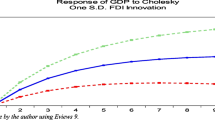Abstract
This study examines the effectiveness of the Reserve Bank of India’s (RBI) intervention policy in the foreign exchange market. An attempt is made to capture volatility spillovers between the RBI’s intervention and exchange rate. The results indicate that the past volatility of intervention has a positive impact on the present volatility of the exchange rate. Similarly the past volatility of the exchange rate, increases the present volatility of intervention. The volatility of the exchange rate is more sensitive to its past shock than the past shock of an intervention. Similarly, the volatility of intervention is more sensitive to the past volatility of exchange rate compared to the past volatility of intervention.


Similar content being viewed by others
Notes
Since, the data on buying and selling operation at less than monthly frequency is not available; we had to construct buying and selling operation by multiplying dummies (D1 for buying D2 for selling operation) with the percentage change in the foreign currency asset, when the changes are positive and negative respectively. RBI intervenes in the foreign exchange market by buying foreign exchange (US $), which in turn increases the stock of foreign currency asset and vice versa.
Ideally, we should employ the capital inflow and outflow as good news and bad news respectively. Instead, negative and positive changes in the 91 days US Treasury bill rate is chosen as proxy for good news and bad news respectively. Since the data on capital inflow and outflow is not available for the sample period. However, the proxy could efficiently capture the impact of good news and bad news on exchange rate.
References
Almekinders GJ (1995) Foreign exchange intervention: theory and evidence. Edward Elgar, Cheltenham
Baig MA, Narasimhan V, Ramachandran M (2003) Exchange market pressure and the Reserve Bank of India’s intervention activity. J Policy Model 25:727–748
Baillie RT, Humpage OF (1992) Post-Louvre intervention: did targets stabilize the dollar?. Federal Reserve Bank of Cleveland Working Paper 9203
Benigno G, Benigno P (2008) Exchange rate determination under interest rate rules. J Int Money Financ 27:971–993
Bollerslev T (1986) Generalized autoregressive conditional heteroscedasticity. J Econ 31:307–327
Bollerslev T, Engle RF, Wooldridge JM (1988) A capital asset pricing model with time-varying covariances. J Polit Econ 96:116–131
Brooks C, Burke PS, Persand G (2003) Multivariate Garch models: software choice and estimation issues. J Appl Econ 18:725–734
Conrad C, Lamla JL (2010) The high-frequency response of the EUR-USD exchange rate to ECB communication. J Money Credit Bank 42:1391–1417
Diebold F, Nerlove M (1989) The dynamics of exchange rate volatility: a multivariate latent factor ARCH model. J Appl Econ 4:1–21
Dominguez KM (1993) Does central bank intervention increase the volatility of foreign exchange rates?. NBER Working Paper No. 4532
Dominguez KM (1998) Central Bank intervention and exchange rate volatility. J Int Money Financ 17:161–190
Dominguez KM, Frankel J (1993) Does foreign-exchange intervention matter? The portfolio effect. Am Econ Rev 83:1356–1369
Dominguez KM, Panthaki F (2006) What defines ‘news’ in foreign exchange markets? J Int Money Financ 25:168–198
Engle R (1982) Autoregressive conditional heteroskedasticity with estimates of the variance of United Kingdom inflation. Econometrica 50:987–1007
Engle RF, Kroner KF (1995) Multivariate simultaneous generalized arch. J Econ Theory 11:122–150
Fischer AM, Zurlinden M (1999) Exchange rate effects of Central Bank interventions: an analysis of transaction prices. Econ J 109:662–676
Hsieh DA (1989) Modeling heteroscedasticity in daily foreign exchange rates. J Bus Econ Stat 73:307–317
Karanasos M, Kim J (2005) The inflation-output variability relationship in the G3: a bivariate GARCH (BEKK) approach. Risk Lett 1:17–22
Kearney C, Patton JA (2000) Multivariate GARCH modeling of exchange rate volatility transmission in the European monetary system. Financ Rev 41:29–48
Klein MW, Rosengren ES (1991) Foreign exchange intervention as a signal of monetary policy. Fed Reserv Bank Boston N Engl Econ Rev 39–49
Knot K, Haan J (1993) Interest rate differentials and exchange rate policies in Austria, The Netherlands, and Belgium. J Bank Financ 19:363–386
Lindberg H (1994) The effects of sterilized interventions through the signalling channel: Sweden1986–1990. Sveriges Riksbank Arbetsrapport No. 19
Ljung MJ, Box GE (1979) The likelihood function of stationary autoregressive-moving average models. Biometrika 66:265–270
Marilyn KW (1999) A Bivariate GARCH Approach to the Futures Volume—Volatility Issue. Eastern Finance Association Meetings: 1–30
Neely CJ (2005) An analysis of recent studies of the effect of foreign exchange intervention. Fed Reserv Bank St Louis Rev 87:685–717
Obstfeld M (1983) Exchange rates, inflation and the sterilisation problem: Germany 1975–1981. Eur Econ Rev 21:161–189
Osterberg WP, Wetmore R (1995) More on the differences between reported and actual U.S. central bank interventions. Federal Reserve Bank of Cleveland, Working Paper 9501
Ramachandran M (2006) On the upsurge of foreign exchange reserves in India. J Policy Model 28:797–809
Ramachandran M, Srinivasan N (2007) Asymmetric exchange rate intervention and international reserve accumulation in India. Econ Lett 94:259–265
RBI Report on Currency and Finance, 1999–2000
Saacke P (2002) Technical analysis and the effectiveness of central bank intervention. J Int Money Financ 21:459–479
Vadivel A (2009) Exchange rate intervention and volatility of exchange rate in India. Indian Econ J 54:143–152
Wong SK, Chau KW, Yiu CY (2007) Volatility transmission in the real estate spot and forward markets. J Real Estate Financ Econ 281–293
Author information
Authors and Affiliations
Corresponding author
Rights and permissions
About this article
Cite this article
Mondal, L. Volatility spillover between the RBI’s intervention and exchange rate. Int Econ Econ Policy 11, 549–560 (2014). https://doi.org/10.1007/s10368-013-0257-4
Published:
Issue Date:
DOI: https://doi.org/10.1007/s10368-013-0257-4




